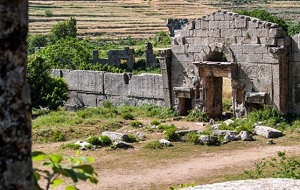Hosn Suleiman is a magnificent ancient temple complex located 14 km from Dreikish city. Its old name is Pathiusi. Although this was a religious center for centuries before, most of the current construction dates from the Roman period. The current name is derived from King Solomon. Visitors can see the huge stones of the temple, with inscriptions in ancient Greek and Latin.
The temple is located on the northwestern slope of Mount “Al-Nabi Saleh”, the Prophet Saleh, about 700 meters above the sea level.
Most impressive, perhaps, is the size of the stones used to construct the outer walls of the complex, which are similar in size to those found in Baalbek, Lebanon.
It is believed that the design of this site as “Hoson Suleiman” may have been linked to the miracle of its construction and the large size of stones that are not built by humans, but by the Jinn. But this belief remains within the framework of imagination and guesswork. The fort was implemented according to the best methods, techniques and equipment of the architecture in the late 2nd century AD, to construct the temple of the god “Zeus” “House of Khikhi”, which is a marvel of architectural excellence.
The temple consists of a semi-rectangular wall with 134 meters long and 85 meters. It was built of very large carved limestone, some of which are about eight meters long, two meters thick and about three meters high. It was built in a way that intertwined and graded on smaller bases, especially in the northern side. The fort has four gates that correspond to the four main directions, where the main gate is located on the northern side. Next to it there are two entrances. The four gates were built in a sculptural style, open to the outside and decorated with exquisite sculptural drawings. At the ceiling of each gate there is a rectangular panel framed with carved sculptures and paintings.
The two-story building temple was built above a rocky base in the center of the courtyard. The structure begins with a six-step wide staircase, then it divided into two separate sides leading to a wide terrace tiled with a large carved stone, with a four-step staircase.
Three golden liras were found from the Fatimid period, which read: “I witness that there is no god but Allah and that Muhammad is the Messenger of Allah and that Ali is the trustee of God.” Collection of silver bracelets and a set of bronze coins from the Roman period were also found during earlier excavation.
Amal Farhat- Homs

